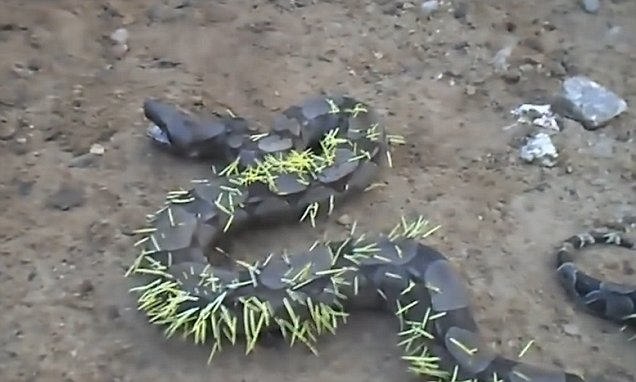Brazil snake eats a porcupine and gets pierced by spikes

Not everyone loves snakes, but after you see this video of a boa constrictor who swallowed a porcupine you can't help but feel bad for the creature. The video appears to show an injured boa constrictor that has been pierced by dozens of white quills. The impaled reptile had apparently tried and succeeded in eating a porcupine in Brazil. The video shows the poor snake withering in pain for two minutes, then to make matters worse it has to defend itself from a barking dog. The cringe-worthy footage captures the boa constrictor as it squirms with dozens of white quills protruding from its skin in Brazil. The impaled reptile had apparently tried to eat the porcupine but unsuspectedly came off worse when the animal inside defended itself with its quills. The snake slithers and thrashes about for almost two minutes, all while a man records its pain. Things got even worse for the reptile when the filmmaker's dog started barking at it. It can take four to six days for the snake to digest it's prey, so it's going to be a tough week for this snake to say the least.
The boa constrictor, which is also called a red-tailed boa, is a species of large, heavy-bodied snakes. The boa constrictor is a member of the family Boidae found in North, South and Central America. You will also find boa constrictors in some islands in the Caribbean. Boa constrictors are a staple of private collections and public displays, as its color pattern is highly variable and distinctive. The boa constrictor can reach lengths from 3 to 13 feet depending on the area it lives and the availability of suitable prey. Clear sexual dimorphism is seen in this snake species, with females being larger in both length and girth than as are the males. As such, the usual size of a mature female boa constrictor is between 7 and ten feet, and 6 and eight feet for the male snakes. Female boa constrictors commonly exceed 10 feet, especially in captivity, where lengths of up to 12 feet or even 14 feet can be seen. A report of a boa constrictor growing up to 18.5 feet was later found to be a misidentified green anaconda snake.
The prey of a boa constrictor includes a wide variety of small to medium-sized mammals and birds. The bulk of a boa constrictors diet includes rodents, but larger lizards and mammals as big as ocelots are also reported to have been consumed. Young boa constrictor snakes eat small mice, bats, birds, lizards, and amphibians. The size of the prey item will increase as the snake gets older and larger. Boa constrictor snakes are ambush predators, so they often lie and wait for an appropriate prey to come along, at which time they attack. However, the snakes have also been known to actively hunt, particularly in regions with a low concentration of suitable prey, and this behavior typically occurs at night. The boa constrictor first strikes at the prey, grabbing it with its teeth and then proceeds to constrict the prey until its death before consuming the prey whole. The snake's teeth also help force the animal down the throat while muscles then move it toward the stomach. It takes the boa constrictor about four to six days to fully digest the food it has eaten, depending on the size of the prey and the local temperature. After this, the boa constrictor may not eat again for a week to several months, due to the snake's slow metabolism.
This is just one of the trending stories you will find on the Daily Mail site. The site also has sports, health, today's top celebrity news, celebrity rumors, science and more. **
Learn MORE at Daily Mail
To help with slow website load, we have put all photos for this article here: View photo gallery.







